#scotland visit may 21
Text


CATHERINE’S STYLE FILES - 2021
26 MAY 2021 || The Countess of Strathearn and Prince William hosted a special screening of Cruella at the Palace of Holyroodhouse for NHS staff in recognition of their vital work throughout the pandemic on the third-day of their visit to Scotland.
#catherines style files#day 3 scotland visit may 21#scotland visit may 21#26.05.2021#cruella screening holyroodhouse palace#holland cooper.#joseph d.#manolo blahnik.#velvet pointed toe pumps#dubai looped sapphire demi parure earrings#style files 2021#duchess of cambridge#dubai looped sapphire demi parure#catherine cambridge#mine.#british royal family#british royals#brf#royalty#catherine middleton#royals#kate middleton#royal#royal fashion#fashion#style#lookbook
43 notes
·
View notes
Text

25 March 2024

The Princess Royal has paid her respects to those who lost their lives in the Lockerbie bombing, which happened 35 years ago.
On 21 December 1988, a bomb exploded on Pan Am Flight 103 from Frankfurt to Detroit as it flew above the Dumfries and Galloway town, killing all 259 passengers and crew onboard.
A further 11 people died on the ground as parts of the wreckage landed on homes in the town.
Princess Anne visited Dryfesdale cemetery and the visitor centre on the town’s outskirts to remember those who lost their lives to the bombing.

She met officials from Dumfries and Galloway Council, as well as others involved in keeping the memory of those who lost their lives alive.
She was joined by Fiona Armstrong, Lord Lieutenant of Dumfries.
Ms Armstrong, also a newsreader and reporter, covered the bombing while working as a journalist.
The princess was shown around the visitor centre and spoke those in attendance.
She signed the visitor guestbook and unveiled a small plaque created in honour of her visit to the site.
Shortly afterwards, she walked through the graveyard to the official memorial for those who were killed as a result of the bombing, where she laid a special wreath signed by her in commemoration of the dead.

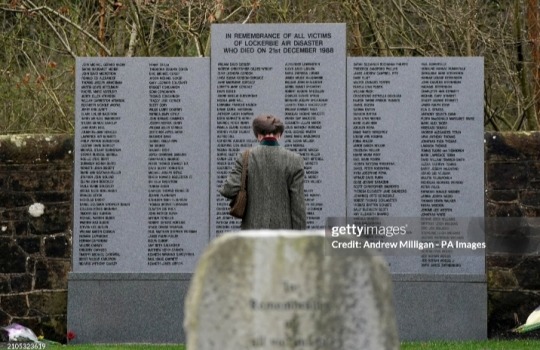

Ahead of laying the wreath, Ms Armstrong said:
“I was there on that night and I saw first-hand how this town rallied, how it copes and has continued to cope over the decades.
You could never be more proud of a community. A disaster like this can never be forgotten.
So much grief, such senseless losses, 270 innocent lives, remembered here on this memorial, each and every name will never be forgotten.
Lockerbie’s moto is forward, and we move together in hope.
Your Royal Highness, your brother, now the King, came here following the disaster.
Your mother, the late Queen; your father, the Duke of Edinburgh; also came here some years after to pay their respects.
And how we are honoured to have you here today, as the Princess Royal, but we also ask you to lay a wreath, please, of remembrance.”
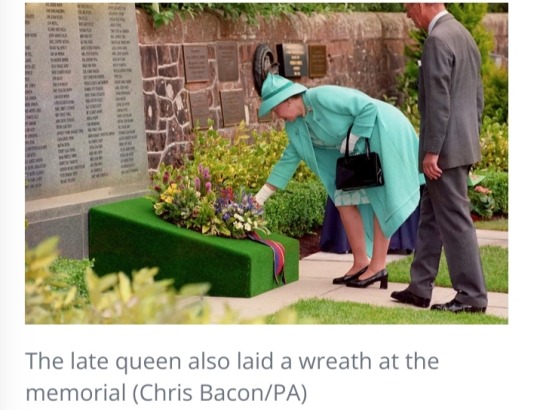
Former Libyan intelligence officer, Abdelbaset al-Megrahi, remains the only person to have been convicted following the atrocity.
He was found guilty of 270 counts of murder by a panel of three Scottish judges, sitting at a special court in the Hague in 2001 and was imprisoned in Scotland.
He was granted compassionate release in 2009 after being diagnosed with terminal cancer and returned to Libya where he died in 2012.
Libyan Abu Agila Masud is alleged to have helped make the bomb.
He is to go on trial in the US in May 2025 facing three charges which he denies.
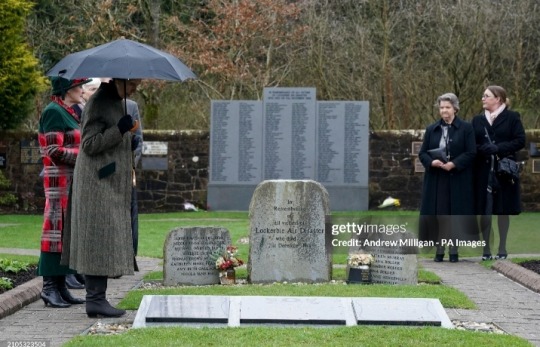
#Princess Anne#Princess Royal#British Royal Family#Lockerbie Air Disaster Memorial#Pan Am Flight 103#Dumfries and Galloway Council
43 notes
·
View notes
Photo
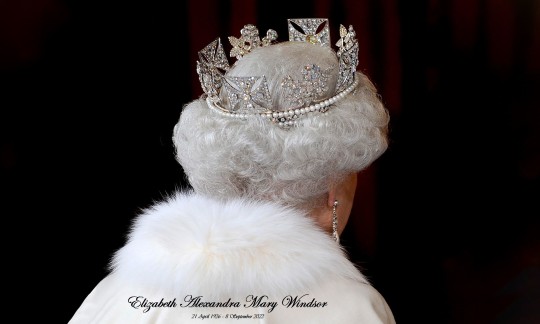
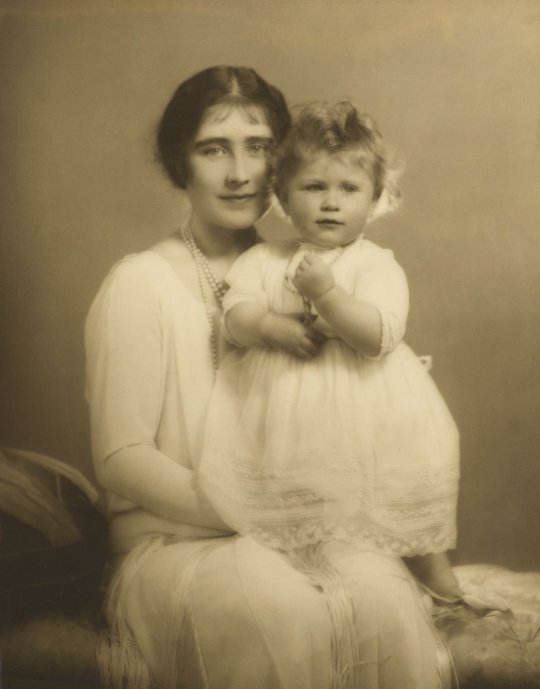


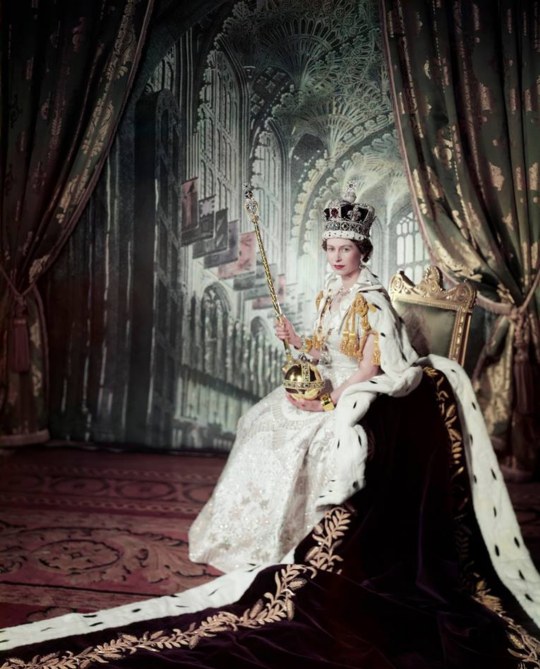
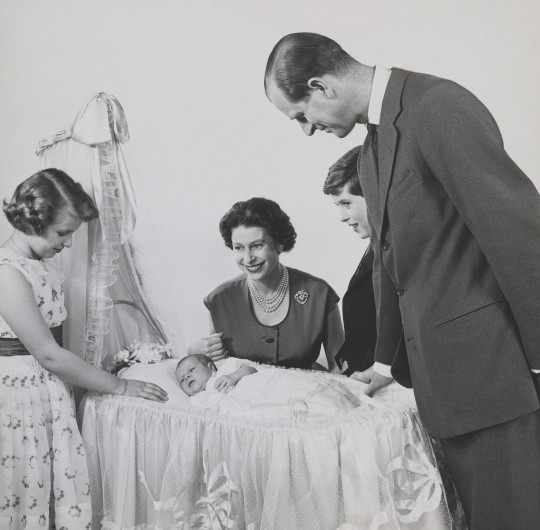


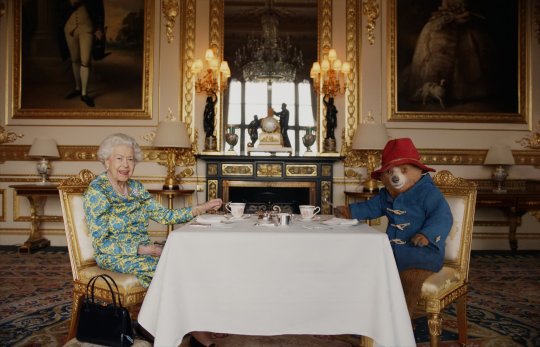

Queen Elizabeth II has died
Queen Elizabeth II, the United Kingdom’ s longest-serving monarch, has died at Balmoral aged 96, after reigning for 70 years.
Elizabeth II (Elizabeth Alexandra Mary; 21 April 1926 – 8 September 2022) was Queen of the United Kingdom and 14 other Commonwealth realms from 6 February 1952 until her death on 8 September 2022.
Her reign of 70 years and 214 days was the longest of any British monarch and the second longest recorded of any monarch of a sovereign country.
Elizabeth was born in Mayfair, London, as the first child of the Duke and Duchess of York (later King George VI and Queen Elizabeth). Her father acceded to the throne in 1936 upon the abdication of his brother, King Edward VIII, making Elizabeth the heir presumptive.
She was educated privately at home and began to undertake public duties during the Second World War, serving in the Auxiliary Territorial Service. In November 1947, she married Philip Mountbatten, a former prince of Greece and Denmark, and their marriage lasted 73 years until his death in April 2021. They had four children together: Charles III; Anne, Princess Royal; Prince Andrew, Duke of York; and Prince Edward, Earl of Wessex.
When her father died in February 1952, Elizabeth—then 25 years old—became queen regnant of seven independent Commonwealth countries: the United Kingdom, Canada, Australia, New Zealand, South Africa, Pakistan, and Ceylon (known today as Sri Lanka), as well as Head of the Commonwealth. Elizabeth reigned as a constitutional monarch through major political changes such as the Troubles in Northern Ireland, devolution in the United Kingdom, the decolonization of Africa, and the United Kingdom's accession to the European Communities and withdrawal from the European Union.
The number of her realms varied over time as territories have gained independence and some realms have become republics. Her many historic visits and meetings include state visits to China in 1986, Russia in 1994, the Republic of Ireland in 2011, and visits to or from five popes.
Significant events include Elizabeth's coronation in 1953 and the celebrations of her Silver, Golden, Diamond, and Platinum Jubilees in 1977, 2002, 2012, and 2022, respectively.
Elizabeth was the longest-lived and longest-reigning British monarch, the oldest and longest-serving incumbent head of state, and the second-longest verifiable reigning sovereign monarch in world history, only behind Louis XIV of France.
She faced occasional republican sentiment and media criticism of her family, particularly after the breakdowns of her children's marriages, her annus horribilis in 1992, and the death of her former daughter-in-law Diana, Princess of Wales, in 1997.
However, support for the monarchy in the United Kingdom remained consistently high, as did her personal popularity. Elizabeth died on 8 September 2022 at Balmoral Castle, Aberdeenshire.
“The Queen is dead, Long live King Charles III”
The Duchess of York with Princess Elizabeth, 30 June 1927 by Marcus Adams (The Royal Collection Trust),
Princess Elizabeth in uniform (1942) by Cecil Beaton (The Royal Collection Trust),
Princess Elizabeth and The Duke of Edinburgh on their wedding day, 20th November 1947 by Sterling Henry Nahum ‘Baron’ (The Royal Collection Trust),
Queen Elizabeth II poses on her Coronation Day on June 2, 1953, in London (Photography by Cecil Beaton),
Queen Elizabeth II with Prince Philip, Duke of Edinburgh and family - 16 Mar 1960 by Cecil Beaton (From the Collection of Queen Elizabeth The Queen Mother),
Queen Elizabeth II and her son, the Prince of Wales, out riding at Windsor Castle I May 18, 1961 (PA),
The Royal coat of arms of the United Kingdom used outside of Scotland,
Queen Elizabeth II Platinum Jubilee 2022 - Platinum Party At The Palace. The Queen Elizabeth II and Paddington Bear having cream tea at Buckingham Palace (BBC Platinum Party at the Palace),
Portrait of Queen Elizabeth II released by The Royal Windsor Horse Show on April 20, 2022 to mark the occasion of her 96th birthday.
#rip#queen elizabeth ii#elizabeth II#queen elizabeth#monarchy#united kingdom#royal#platinium junilee#windsor#markus adams#cecil beaton#theroyalcollectiontrust#paddington#bbc#balmoral#diana#king charles III#princess anne#prince andrew#prince edward#liveunique#history#britsh history#british royality
345 notes
·
View notes
Text

Prince William, Earl of Strathearn test drives the Extreme E Odyssey 21 electric vehicle during his visit to the Knockhill Racing Circuit in Fife, Scotland. — 22 May 2021
60 notes
·
View notes
Text
James I (and VI) & George Villiers
Continuing my series of learning about things referenced in the book, I'm looking at things referenced in Alex & Henry's visit to the V&A Museum. These are all tagged #a series of learning about things that are referenced in the book, if you want to block the tag.


"Actually . . . you remember how I told you about the gay king, James I?”
“The one with the dumb jock boyfriend?”
“Yes, that one. Well, his most beloved favorite was a man named George Villiers. [...] He stood in front of the Privy Council and said, ‘Christ had John, and I have George.’"
-Chapter 10, Red White & Royal Blue
-----
King James I (in England, in Scotland he was James VI) ruled from 1567 (Scotland) and 1603 (England & Ireland) until his death in 1625. He was the son of Mary, Queen of Scots, and was crowned King of Scotland aged 13 months - after her forced abdication. He gained full control of government in 1583, and 6 years later married Anne of Denmark - they had seven children, but only three survived to adulthood, with one dying aged 18. Then-Queen of England, Elizabeth I, died childless in 1603 and James VI of Scotland was passed the crown of England without protest.
George Villiers, the 1st Duke of Buckingham, was born in 1592, to a minor gentleman, Sir George Villiers. Aged 21, he caught the eye of King James I and gained the King's patronage. He was described as "the handsomest-bodied in England", and also gained the support of the King's wife, Anna. Villiers was made a gentleman of the bedchamber - whose duties involved assisting the King as he dressed and ate, and also to provide companionship - in 1615, and in 1623 he was elevated to a dukedom, the first commoner in more than a century to be granted this.
Their relationship was the subject of rumours at the time, with many assuming they were sharing a bed. As Henry mentions in the same scene as the quote at the top, 17th century poet de Viau wrote "it is well known that the king of England / fucks the Duke of Buckingham." King James' nickname for Villiers was "Steenie", after Saint Stephen - who was described as having "the face of an angel".
The full quote preceding "Christ had John, and I have George" adds to the display of the depth of the king's feelings for Villiers. He said in 1617 before the Privy Council: "You may be sure that I love the Earl of Buckingham more than anyone else, and more than you who are here assembled. I wish to speak in my own behalf and not to have it thought to be a defect, for Jesus Christ did the same, and therefore I cannot be blamed. Christ had John, and I have George."
Sources/Additional Reading:
Wikipedia - James I & VI
Wikipedia - George Villiers
Wikipedia - Succession to Elizabeth I
Wikipedia - Union of the Crowns
BHO - The bedchamber: Gentlemen of the Bedchamber
Wikipedia - Personal Relationships of James I & VI
The History Vault - James I & VI and his male ‘favourites’
#rwrb#red white and royal blue#rwrb movie#alt text added#elio's#elio's meta#long post#a series of learning about things that are referenced in the book
32 notes
·
View notes
Text



The young King James VI made his first official visit to Edinburgh on September 30th 1579.
James VI had spent his childhood at Stirling Castle. Now he came to Edinburgh to begin his adult rule. aged 13.
Born in 1566, he was the product of Mary’s ill-fated marriage to Henry, Lord Darnley. Darnley’s assassination in early 1567, and Mary’s subsequent over-hasty marriage to one of its perpetrators, Lord Bothwell, triggered events that led to Mary’s downfall.
James VI became king of Scotland in 1567 when Mary was forced to abdicate.
According to the writings of David Moysie, James VI left Stirling on 29 September 1579 despite a storm. He had lunch at Dunipace and dinner at Linlithgow Palace where he stayed the night, and came to Holyroodhouse the next evening. The town lined the road with men in armour and a salute was fired from Edinburgh Castle. The streets were cleared of beggars, executed criminals were removed down (from their pikes on the tolbooth) and the streets thoroughly cleaned.
His entry to the town was marked by a ceremonial Royal entry. James arrived from Dalkeith Palace. The processional route went from the West Port, to the Overbow, to the Tolbooth, to St Giles Kirk, the Mercat Cross, the Salt Tron, the Nether Bow, Canongate Cross, and Holyrood Palace
The gates of the town, the tollbooths of Edinburgh and the Canongate, and other buildings were painted white with limewash, called "calk". Householders along the route were asked to hang the external stairs with tapestry and "Arras works".
At the West Port the king was met by 32 burgesses of Edinburgh, whose names are recorded, who carried a canopy made of purple velvet. John Shairp gave a speech in Latin. There was a tableau vivant of the Judgement of Solomon. At the Overbow Cupid gave James the keys to the town. Cupid was played by a boy who descended in a globe. At the Tolbooth four maidens (probably played by boys) represented Peace, Justice, Plenty and Policy, a scene relating to the four Cardinal Virtues. At St Giles Dame Religion invited the king to hear a sermon on the duty of kings and Psalm 21 was sung. . Afterwards, at the Mercat Cross Bacchus shared out wine. At the Salt Tron the genealogy of the Scottish monarchy was presented, perhaps using portraits. The king's horoscope was presented an actor playing Ptolemy at the Netherbow Port. At the Canongate Cross a scene represented the abolition of the Pope's authority in Scotland.
At Holyrood Palace a new lodging was prepared for the king's favourite Esmé Stewart next to the royal apartment. A course or tournament ground made of sand for "running at the ring" was laid at Holyroodhouse. Celebrations continued at Dalkeith Palace, hosted by the former Regent Morton.
Similar pageantry was used in September 1561 when Mary, Queen of Scots had made an Entry, and in May 1590 at the Entry and Coronation of Anne of Denmark.
A short account of the events occurs in the chronicle, The historie and life of King James the Sext, written in Scots;
At the Wast Port of Edinburgh, he was ressavit be the Magistrats of the toun under a pompous payle of purple velvet. That port presentit unto him the wisdome of Solomon, as it is written in the thrid chapter of the first buik of the Kings : That is to say King Solomon was representit with the tua wemen that contendit for the young chylde. This done, they presented unto the King, the sworde for the one hand, and the scepter for the uther.
And as he maid forder progres within the toun, in the streat that ascendis to the castell, thair is an ancient port, at the whilk hang a curious globe, that opnit artificiallie as the King came by, wharin was a young boy that discendit craftelie, presenting the keyis of the toun to his Majestie, that war all maid of fyne massie sylver; and thais war presentlie ressavit be ane of his honorable counsall at his awin command. During this space, Dame Music and hir scollars exercesit hir art with great melodic. Then in his discence, as he came foment the hous of Justice, thair shew thayme selfis unto him, foure gallant vertewous ladeyis; to wit, Peax, Justice, Plentie, and Policie; and ather of thayme had an oraison to his Majestic.
Tharefter, as he came towart the chief collegiall kirk, thare Dame Religion shew hirself, desyring his presence, whilk he then obeyit be entring the kirk; whare the cheif preacher for that tyme maid a notable exhortation unto him, for the embracing of Religion and all hir cardinall vertewis, and of all uther morall vertewis. Tharefter, he came furth and maid progres to the Mercat Croce, whare he beheld Bacchus with his magnifik liberalitie and plentie, distributing of his liquor to all passingers and behalders, in sik apperance as was pleasant to see. A litill beneth is a mercat place of salt, wharupon was payntit the genealogie of the Kings of Scotland, and a nomber of trumpets sounding melodioslie, and crying with loud voyce, "Wealfayre to the King".
At the east port was erectit the conjunctioun of the planets, as thay war in thair degreis and places the tyme of his Majesteis happie nativitie, and the same vivelie representit be the assistance of King Ptolome : And withall, the haill streits war spred with flowres; and the forehowsis of the streits, be the whilks the King passit, war all hung with magnifik tapestrie, with payntit historeis, and with the effegeis of noble men and wemen : And thus he past owt of the toun of Edinburgh to his palice of Halyruidhous
Note the last words on the description, “ his palice of Halyruidhous “ A couple of years ago someone question my use of the wording “Holyroodhouse” saying she had never heard the Palace being called that before, well this confirms that over 300 years ago that this was being used, rather than Holyrood Palace, as is often used.
The king was given a cupboard of silver gilt plate made by the Edinburgh goldsmiths Edward Hart, Thomas Annand, George Heriot, Adam Craig and William Cokky. It was valued at 1000 English marks. This included a basin and a laver, two flasks, six cups and covers, four candle holders, a salt, a silver salver, and dozen silver plates. William Fairlie was asked to oversee the gilding of the silver on 8th October and assist Henry Nesbit make an account of the expenses. The wealthy merchant and "Customar" of Edinburgh Robert Gourlay, a supporter of Regent Morton, complained to the Privy Council of Scotland when he was asked to contribute £30.
An account for repairs and building work at Holyrood in August and September 1579 survives. The works were supervised by William MacDowall, the royal Master of Work. Mention is made of slating the roof of a "Dancing House", carpenters who made a great chest for the king's pantry, glazing the chamber for "Lord Lennox", and a pavement in the chapel. New rooms were made for William Murray, and for Jerome Bowie, Master of the Wine Cellar. George Wallace or Vallance and his workman plastered the old hall, the chapel and the gallery, and painted the council house with chalk distemper paint. Women worked cleaning chambers in the tower, the old hall, the forework, and the gallery, and the inner close or courtyard. Their wages were two shillings a day.
The visit by James was a huge success. Everyone was delighted to see their king and with the excitement of once again having a royal court in Edinburgh.
7 notes
·
View notes
Text
What Are Fuath?

Fuathan (Fuath singular) have two different meanings associated with the name.
For one meaning, the name represents one singular type of creature. This creature has the shape of a man, but webbed hands and feet and a golden mane, and was popularized by folklorist John Francis Campbell in his book Popular Tales of the West Highlands.
“From all these it appears that the Fuath in Sutherland is a water spirit; that there are males and females; that they have web-feet, yellow hair, green dresses, tails, manes, and no noses ; that they marry men, and are killed by light, and hurt with steel weapons; that in crossing a stream they become restless.
From the following stories it appears that they are hairy, have bare skin on their faces, and have two large round eyes.”
Popular Tales of the West Highlands” by John Francis Campbell (1862)
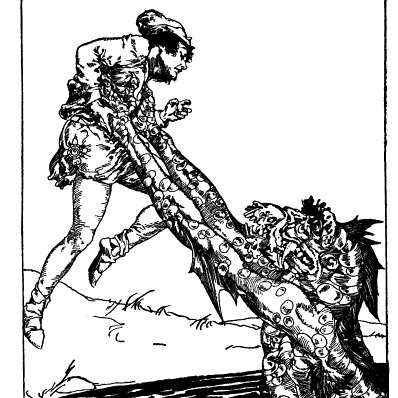
(A “fua” of the river grabs hold of a human.—Illust. Willy Pogany. Colum, Padraic (1916). King of Ireland’s son)
The second, and slightly more popular meaning, is that word as a category for several different types of water-type creatures with evil intent.
“Fuath: a spectre, a kelpie, a demon, a water-fiend frequenting glens, rivers, and waterfalls.”
Carmina Gadelica, Volume 2, by Alexander Carmicheal, [1900]
All it takes to be placed in the category is to be a water-type with evil intent; the hint of which is actually right in the name, which means “aversion,” or “hatred.”
The major differences to these meanings even caused a bit of debate between folklore writers.
“The attributes of the Fuath are different in different tales, and Mr. Campbell (Tales of the West Highlands, ii. 191) has fallen into the error of conjoining attributes ascribed in several stories, and representing the Fuath as a water spirit, having web-feet, tail, mane, etc.”
Witchcraft & Second Sight in the Highlands & Islands of Scotland��by John Gregorson Campbell (1902)
Going by the second meaning, everything from a kelpie to certain water sprites may fall under the “fuath” category. In this way, it can be helpful to describe a creature in a story without knowing the exactly type. For example, if you say you were attacked by a fuath, people would know you mean an evil water-type creature.
In many stories, it is common for a person to be attacked by a fuagh, only for their dog to leap to protect them. In some stories, the dog wins but loses all of its hair.
“The dog at last disposed of the Vaugh , but he lost all his hair in the scuffle . The poacher became grey from terror in a single night , and we have reason to believe he did not again visit the pools of the Shin after dusk for any illicit purposes.”
THE VAUGH , THE POACHER , AND THE DOG from The Folklore Journal, Volume 6; Volume 21 By Folklore Society (Great Britain): The Folklore of Southerlandshire
Sadly, it is common for the dog to die the next day in stories.
Like with most fairies, they are affected by iron, but interestingly, some area also harmed by sunlight.
“One of John Ray Bethune’s forbears, who lived at Inveran, laid a bet that he would seize the kelpie of Moulinna Vaugha, or Moulinna Glannan, and bring her bound to the inn at Inveran.
He procured a brown , right-sided maned horse, and a brown black-muzzled dog, and by the help of the latter, having secured the Vaugh, he tied her on the horse behind him, and galloped away. She was very fierce, but he kept her quiet by pinning her down with an awl and a needle .
Crossing the burn at the further side of Loch Migdall, she became so restless that he stuck the shoemaker’s and the tailor’s weapons into her with great violence .
She cried out, “Och ! och ! cur anum am minme crourm ; L ‘ cum asum au ‘ hail chiul rouach,” which is, being interpreted,
“Pierce me with the crooked awl, but keep that small sharp needle ont of me.”
When he reached the clachan of Inveran, where his companions were anxiously waiting for him, he called out to them to come out and see the Vaugh. Then they came out, with lights, but as the light fell upon her she dropped off, and fell to earth, like the remains of a fallen star, a small lump of jelly.
[ These jellies are often seen on the moors , and are called “dropped stars.” ]
The Folklore Journal, Volume 6; Volume 21 By Folklore Society (Great Britain): The Folklore of Southerlandshire
So, putting this all bluntly, a fuath is commonly a category of water fairies that have a tendency to be evil, but some people use it to describe a single creature type.
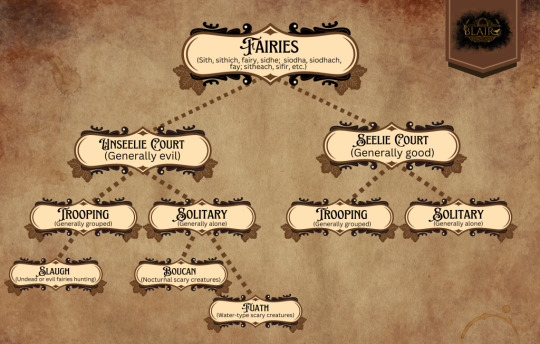
#fuath#fauth#scottishfolklore#scottish folklore#scottish myths#scottish mythology#FairyBasics#fairybasics#FairyTypes#fairytypes#fae#faerie#fae folk#fairies#fairy#unseelie#unseeliecourt#ScottishFolkoreBasics#MiscScottishFairies#WaterTypeFairies
31 notes
·
View notes
Text
My Fitzsimmons headcanons that nobody asked for
Okay, I would just like to state that this is my first time writing long posts like this, so it’s definitely not aesthetic and stuff, but I tried alright 😭 These headcanons are mostly about Alya tbh (and her relationship with Owen) because she’s definitely one of my favourite characters.
1. Jemma is a horrible driver. She got her license after moving to Perthshire by some miracle, but she only drives when it’s an emergency and Alya isn’t with her. The last time she borrowed Fitz’s car, she got three speeding tickets in one day.
2. They don’t want Alya to skip too many grades so that she can have some sort of social life, but they agree to let her skip two years after a lot of begging from the little girl.
3. Alya gets an offer to study at Coulson academy when she’s only 13, despite not having any PHDs or degrees, but it’s an easy offer to pass.
4. Daisy visits them ALL the time. Coulson sometimes jokes that she only returns to Earth to see Alya. She always rolls her eyes, and goes to stay with him and May for a while after.
5. Owen Shaw turns out to be Bobbi and Hunter’s kid. They change their names after the Romanian police puts them on the most wanted list, and move to Scotland- because they know Fitzsimmons live there.
-Fitz facepalms when he finds out. But he’s less devastated once he agrees that atleast it’s Hunter and Bobbi’s kid that his little star ends up with.
-They obviously introduce her to Owen when she’s still very young, and Jemma tries to ‘give them hints’ countless times throughout the course of their friendship. Alya’s smart, though, and figures out that something is up. Her parents tell her the truth not too long after that.
6. Alya and Owen turn out to be best friends, and when they’re young- they decide to ignore everything their parents said about their future altogether, pretending they never even heard.
7. When she was 13, Alya once put hot pink streaks in her hair after looking at old photos of her Aunt Daisy. It looked so bad that she had to cut off a part of her hair only two days in. That’s the last time she ever experiments with her hair.
8. Daisy and Jemma call each other sisters barely a year after their last mission, with Jemma often saying that her sibling is out of town when Daisy’s back in space.
9. When Alya is 16, Daisy finally convinces her to cut herself some bangs- after the younger girl confides to her that it’s something she’s always wanted to do. Fitz almost bans her from visiting Alya completely, but Daisy just coolly replies that she has to ‘be the cool aunt somehow, Fitzy! Honestly!’
10. Alya goes through countless relationships in the course of her high school years, even going through a ‘heartbreaker' phase when she’s around 15. Her and Owen become distant too after some time, but they find their way back to each other.
11. Jemma starts working as a biology teacher in a school nearby when Alya also starts going to school regularly. Fitz joins as a consultant for S.H.I.E.L.D. 4 years after, agreeing to go by a fake name and after assurance that there would be no stored records of his help.
12. Alya and Owen finally decide to try dating each other when she’s 22, and he’s a little over 21. They date each other for five years... after that; they get married.
-They have a son after two years of marriage, and name him Deke after Alya’s parents convince her that he was an old friend who helped them out during their S.H.I.E.L.D. days.
-Alya, to this day, doesn’t know what her mother meant when she told her father ‘now you’ll have to deal with him all over again’ when Deke was born, to which her father only groaned (but she could see him smiling).
#agents of shield#fitzsimmons#headcanon#fitzsimmons headcanons#alya fitzsimmons#marvel headcanons#marvel
94 notes
·
View notes
Text
Timeline part 3 February 2022 - July 2022
Timeline part 3 covering February 2022 - July 2022
See for previous dates part 2 here
He flew back from NZ to London (not via LA) during the storm Eunice, a fan spotted him on February 19 2022 in London and reported about it. Doing promo and some photoshoots and having a little family dinner the evening before
This morning and the London Premiere of OL S6 on February 24 2022.
Again on the move few days later February 28 to NYC where he started with a conversation with Josh and a very busy schedule of promo and photoshoots. Numerous pics and fan pics. But still had time to go see a rangers game and being caught by a pap with MC which didn't take place on March 7 as the article mentions, but in the weekend before, as on March 7 he was in
LA for OL promo, talkshows and FYC panel and on a podcast of tompapa which gave away he was in LA on March 7 2022
Meanwhile we learned that his brief visit to Kansas City would be for a (quite expensive) con, on March 12 where he slipped and hit his head at the cardoor and since then has a scar
He flew back to London from there and was spotted by fans on March 15 2022. Then went to a Triumph bikers event with Nic R on March 18. Briony let us know on March 19 how she was away for the weekend working on something special, which (as suspected) was the photoshoot for the bookcover. He posted a motorbike pic from his home on March 20.
Meanwhile the OL crew was already gearing up as of mid March 2022 according to schedules of extras. And we saw the first pics in April, on April 7 S, boat scenes at the docks,
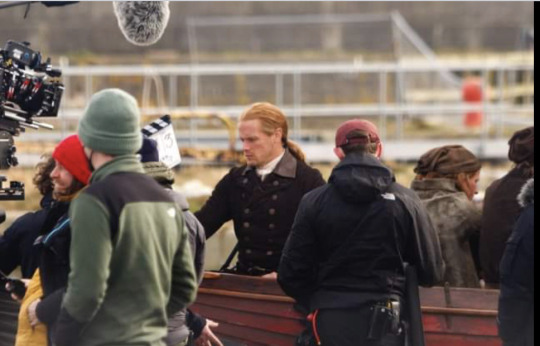
Still he had time to get to NYC on April 17 during Easter break, no not for MC but for a theatre visit at the BAM theatre seeing James McAvoy in Cyrano where he was also spotted by a fan that weekend.
And back to OL filming. Jon Muir at Dunbar was set up and reported already on April 8 2022, where we saw them filming on April 20 and some videos of the BTS pics
But seems a visit to London and a walk with Katrina around 25 April did fit in his 'busy' filming schedule also, having a drink with CB on April 29 in Glasgow. The birthday weekend was for the MPC gala and tree planting
Meanwhile Midhope Castle posted dates the castle was closed due to OL filming. And there was a live IG on May 2 with S+C.
In May we could almost follow every weekend what he was doing. As it seems AN stayed in Scotland and they were seen multiple times in Edinburgh. Beginning with the MPC Gala, birthday weekend Friday May 6 he was spotted in Edinburgh by a fan, and Saturday in the Balmarol hotel. They seem to have been at the Johnny Walker distillery in Edinburgh and a week later he was spotted at Glenturret distillery and in Glasgow for a Sunday lunch at Crabshakk Botanics on May 15. Next weekend of course was reserved for the DGR, after NIck R showing us around the house and especially the garage where the bikes were, we got a video to reveal the helmet on May 20 he'd be wearing for the DGR, the weekend started the next day at Murray field where some fans spotted him and his own selfie with his 'team'. Several pics and videos of the ride itself on May 22 and nice of Nick R to post his weekend video so we could follow it all by the minute.
Meanwhile new sets where discovered, the Hunter house
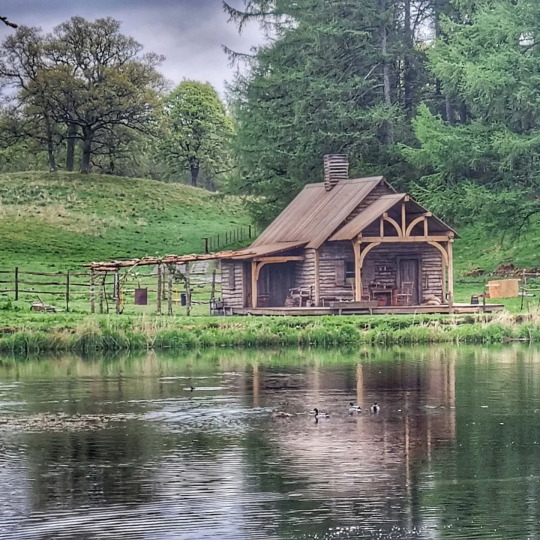
And filming seemed to be going on at Midhope Castle, we got to know about nightshoots on May 27
During Pentecost weekend he stayed in Amsterdam per the interviewer of Esquire who talked to him on zoom from his Amsterdam hotel and a fan pic taken on June 4
Suspect is about to be released and he's doing promo for it, a number of interviews and a live appearance on Loraine on June 16 while he is in London, and also posts a 'father's day promo' from his hotel room at the Soho hotel. He also recorded the Gold Derby interview there and BBC the Edit on June 21
Trailers were spotted at Pollok Park in Glasgow on June 22 where filming seems to be going on
On June 25 he at the Giorgio Armani Tennis tournament at the Hurlingham Club with his mother, a fan took a fan pic with him
Next appearance is at the Highlander con in Glasgow on July 2nd, he's filmed by many (and RR) leaving the building. Of course many fan pics
Outlander filming was seen in Newmills on July 5 though most likely not all the main cast. SS was there and (as we learned later on Chris Fulton as Rob Cameron)
July 7 2022 in Glasgow he was receiving his honorary Doctor degree for the RCS and thanked them with a recycled speech. The next day (July 8) a fan posted a picture with him at juicy uk, a superfood bar
After that last pic things went a little quiet, it seems the 6 weeks break for filming had started mid July. He posted a story signing bookplates on his deck in his garden on July 22nd. The next pic he posted was on July 23, the infamous bucket hat pic, which seems to be in the area his friend from EDA Tommy had his bachelor party in Glasgow (or part of it). There were some videos, there is one where supposedly his head is seen.

Other Timlines
Part 1 August 2020
Part 2 September 2021
Part 4 August 2022
19 notes
·
View notes
Text


CATHERINE'S STYLE FILES - 2021
27 MAY 2021 || The Countess of Strathearn hosted Mila Sneddon and her family for tea at the Palace of Holyroodhouse on her and Prince William's final day in Scotland.
#scotland visit may 21#day 4 scotland visit may 21#tea with mila#mila ❤️#duchess of cambridge#catherine cambridge#catherines style files#style files 2021#mine.#me+em.#boden.#emmy london s.#emmy london.#rebecca pumps#missoma.#rhodochrosite mini pyramid charm hoop earrings#amaia kids.#british royal family#british royals#kate middleton#brf#catherine middleton#royalty#royals#mila sneddon#royal fashion#style#lookbook#fashion
30 notes
·
View notes
Text
10 best royal exhibitions to continue the Coronation celebrations, from Buckingham Palace to Blenheim
The day of the Coronation is over but these remarkable royal exhibitions across the UK means the excitement doesn’t need to be
By Natasha Leake
18 May 2023
The glow from King Charles III’s Coronation is starting to fade, but there is plenty more pomp and ceremony to be discovered at these extraordinary royal exhibitions currently being staged across the country.
Stately homes and royal palaces have transformed their sumptuous rooms into backdrops for stunning showcases of royal regalia, period costumes and mementos of past Coronations.
From Blair Castle to Castle Howard; Blenheim to Buckingham Palace, book a date at one of these must-see royal exhibitions to keep the celebrations going.
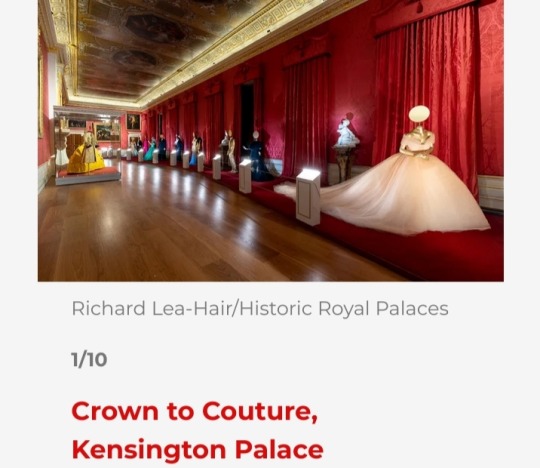
Through a carefully curated selection of more than 200 pieces, the Kensington Palace fashion exhibition draws parallels between the pomp, ceremony and performance of the contemporary red carpet and the pressure to ‘see and be seen’ at Georgian court.
One-of-a-kind creations worn by Lizzo, Katy Perry and Lady Gaga et al. are juxtaposed with outfits worn by 18th century movers and shakers in the State Apartments, which, handily, is where the showcase is staged.
Pictured: A row of magnificent outfits in the King’s Gallery at the Crown to Couture
5 April - 31 October 2023
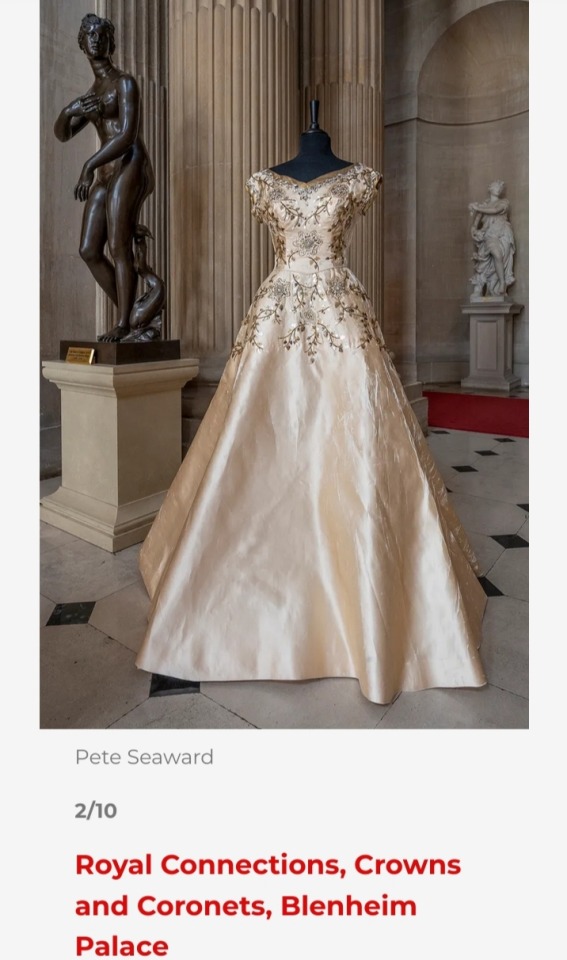
Blenheim Palace is using the occasion of the Coronation to celebrate its historic connection with the Royal Family.
With a collection of previously unseen artefacts, crowns, coronets, robes, and photo albums, take a trip into the world of royal fashion with an impeccably restored Norman Hartnell silk gown, worn by the then Rosemary Spencer-Churchill to the Queen’s Coronation in 1953.
Also on display are costumes from Bridgerton and The Crown, and a page from a Blenheim visitor’s book, which includes the elegant inked signatures of Wallis Simpson (the future Duchess of Windsor) and her second husband, Ernest A. Simpson.
Pictured: The restored Maid of Honour Coronation dress worn by Rosemary Spencer-Churchill to the Coronation of Queen Elizabeth II in 1953.
19 March - 30 July 2023

Originally launched in 2022, the award-winning Castle Couture exhibition returns this summer to Blair Castle, the ancestral home of the Atholl family, with an extended edition that showcases statement designs, intricate embroidery, innovative textiles, and style influences from the 18th century through to the 20th century.
Among the highlights are delightfully delicate ostrich feather and Brussels lace fans by the renowned Parisienne craftsman Duvelleroy, the appointed supplier to Queen Victoria.
There are also pieces from the personal collection of the late Katharine Stewart-Murray, Duchess of Atholl, Scotland’s first Scottish female Member of Parliament.
Pictured: This ballgown would have been worn by Lady Glenlyon (later Anne, Duchess of Atholl) during the visit as they dined with the royal couple.
1st April – 28th October 2023
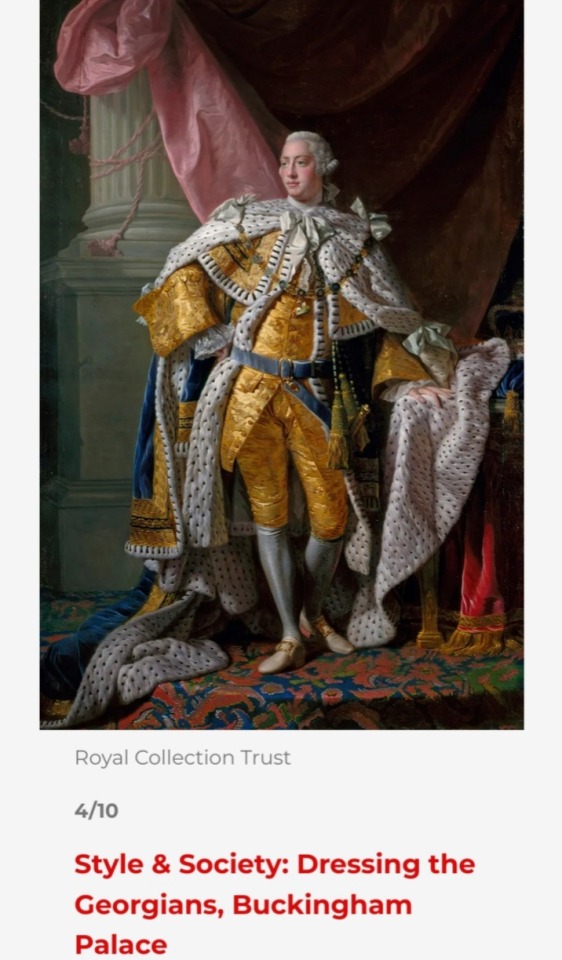
In a homage to the Regency period, visitors are invited to take a step back into the world of the Georgians with an exhibition that looks at how fashion trends reflected the significant trade, travel and technological advances of the period.
A highlight of the exhibition is a rarely displayed, full-length portrait of Queen Charlotte (of Bridgerton fame) by Thomas Gainsborough, dated from around 1781, which usually hangs in the White Drawing Room at Windsor Castle.
The showcase also features one of the earliest surviving British royal wedding dresses: a stunning gown worn by Princess Charlotte of Wales in 1816.
Pictured: A painting of King George III by Allan Ramsay, c.1761–2.
21 April – 8 October 2023

The late Queen Elizabeth II’s beloved corgis captured the hearts of the nation the late monarch’s funeral.
Now they are being celebrated as part of a free exhibition at the Wallace Collection, in central London.
The one-room display features touching imagery of the Queen with her corgis.
It coincides with the museum’s exhibition, ‘Portraits of Dogs: From Gainsborough to Hockney,’ which celebrates human devotion to dogs over the centuries through a carefully curated selection of 50 paintings, sculptures, drawings and taxidermy.
Pictured: Queen Elizabeth II sitting on rocks on the Garbh-allt Burn with two corgis on the Estate at Balmoral Castle, Scotland, September 1971
8 March – 25 June 2023
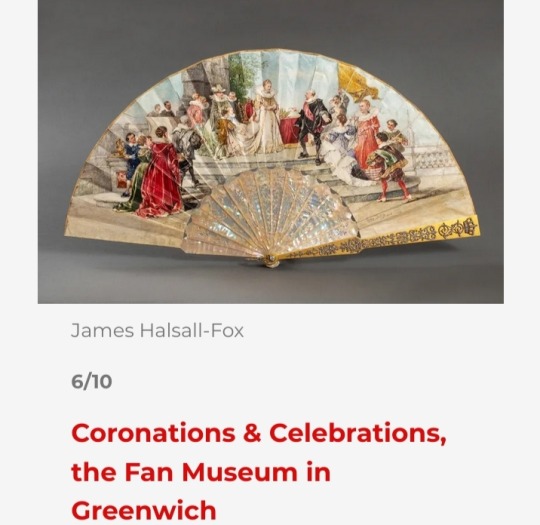
Situated in a pair of beautifully restored early Georgian townhouses, the exhibition showcases centuries of royal fans from across the globe, including a special, printed, English fan marking the restoration of Charles II and the contemporary fans made by The Fan Museum in honour of the late Queen Elizabeth II’s Diamond Jubilee.
The exhibition promises to be ‘not merely a look back on what has been but a rally of hope for what is to come.’
King Charles III has also taken an avid interest in the Fan Museum’s work.
Pictured: A Belgian folding fan dating from 1881
1 February - 24 June 2023
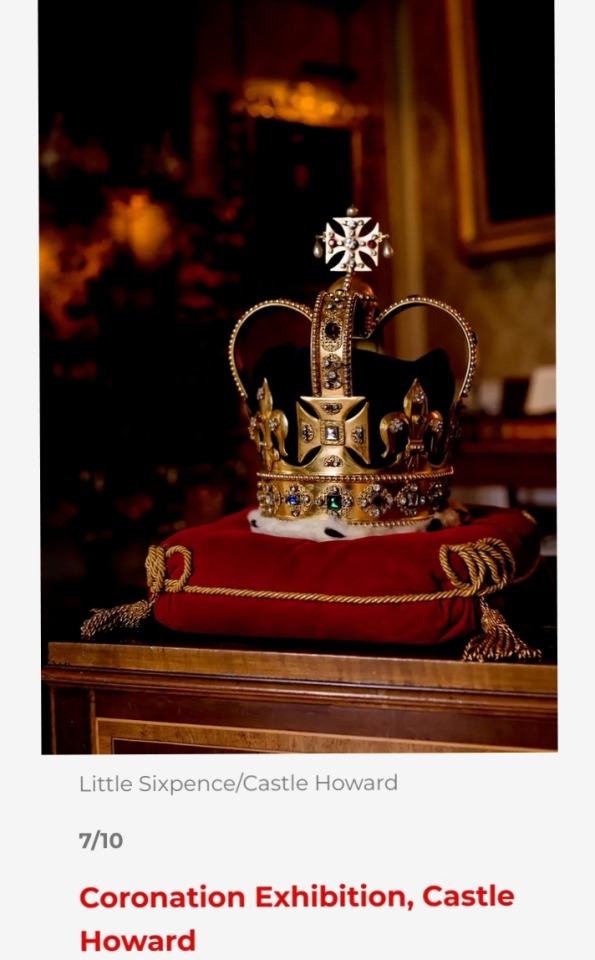
The Long Gallery at Castle Howard, home to the Howard family for more than 300 years, is hosting an incredible exhibition featuring an exact replica of the Crown Jewels and peers’ robes worn to coronations gone by.
Set in 10,000 glorious acres on the edge of the Yorkshire moors, Castle Howard was commissioned in 1699 by the 3rd Earl of Carlisle from Sir John Vanbrugh, who later conceived Blenheim Palace.
The 1st Earl of Carlisle was descended from Lord William Howard, the youngest son of Thomas Howard, 4th Duke of Norfolk (the current Duke of Norfolk organised the King and Queen’s Coronation).
Pictured: Castle Howard’s replica of the Crown Jewels
From April 1

During the last Coronation, the hotel had to secure extra flagpoles in order to fly banners for the many different royals and dignitaries staying there.
The archive overflows with Coronation material, which is why Claridge’s unveiled a space showcasing the hotel’s status as ‘the Royal Hostelry.’
Mementos on display include pages from Queen Victoria’s diary, fans created for the coronation of King George V and Queen Mary, and Claridge’s menus and cocktail cards created for the coronations of King George VI in 1937 and Queen Elizabeth II in 1953.
Pictured: A collection of royal mementos including featuring a book of 53 photographs of the then Prince of Wales, and an order of service from the Coronation of Queen Elizabeth II
Until May 31
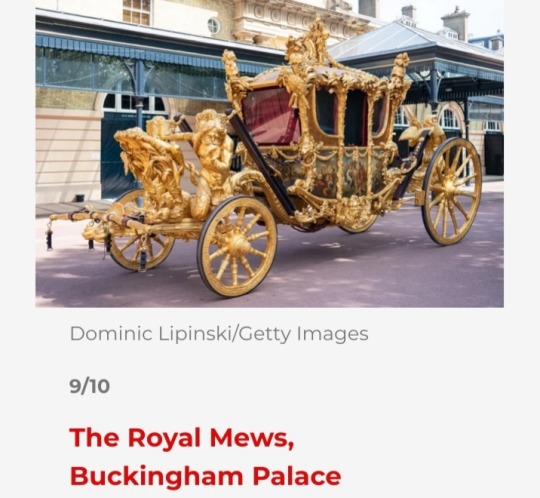
The world watched in awe as the newly crowned King Charles III and Queen Camilla processed from Westminster Abbey back to Buckingham Palace in the Gold State Coach.
This extraordinary regal treasure is available to view at the Royal Mews at Buckingham Palace, alongside the Diamond Jubilee State Coach, which transported Their Majesties to the Abbey ahead of the service.
Also housed in the mews? The famous Windsor Grey horses, which drew the magnificent carriages on the day.
Pictured: The Gold State Coach
2 March - 30 October 2023

At the epicentre of the Coronation was Westminster Abbey. So where better to delve into the gilded history of the captivating service?
A new exhibition in the Chapter House reveals the key elements of the royal ceremony, which has taken place at the Abbey for nearly a thousand years.
Featuring historic illustrations and archive photography, it promises to unpack and explain the Coronation’s magnificent ceremonial regalia and objects.
8 April - 30 September 2023
#King Charles III#Coronation 2023#Kensington Palace#Blenheim Palace#Rosemary Spencer-Churchill#Queen Elizabeth II#Queen’s Coronation 1953#Blair Castle#Castle Couture#Atholl family#Duvelleroy#Queen Victoria#Katharine Stewart-Murray#Regency Period#Thomas Gainsborough#Windsor Castle#Princess Charlotte of Wales#Lady Glenlyon#King George III#corgis#Wallace Collection#royal fans#The Fan Museum#Howard Castle#Earl of Carlisle#Duke of Norfolk#Claridge's#Royal Mews#Westminster Abbey#Windsor Grey horses
20 notes
·
View notes
Text
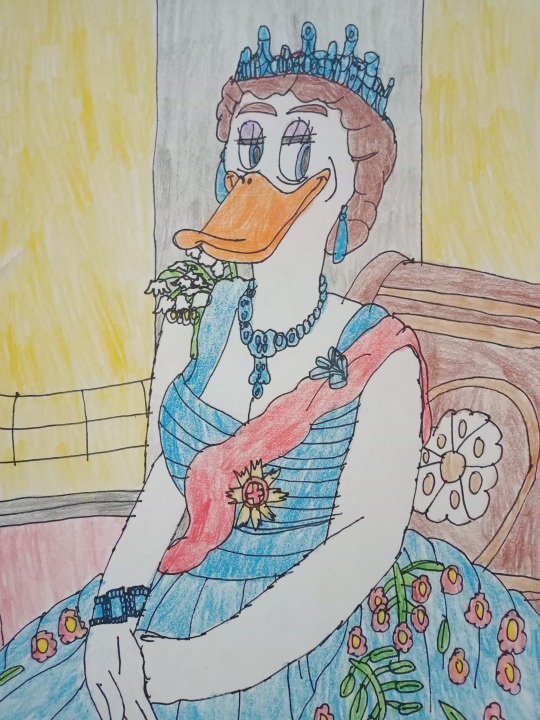
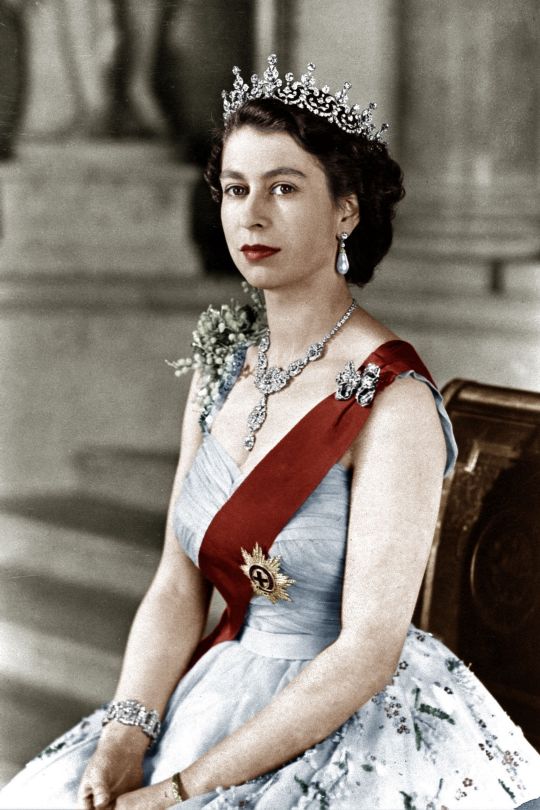
Portrait of Queen Elizabeth II in young days in Duckverse - Tribute to her (1926-2022)
Please, this is not a parody, but a tribute to the Royal Majesty of United Kingdom of Great Britain and Northern Ireland plus the British Commonwealth. Queen Elizabeth II when she was young woman and ascended the throne, but in Duckverse way. Sorry about this, but I haven't mastered portraits in human form yet, but I hope to learn. I thank you for your understanding.
Elizabeth Alexandra Mary as Elizabeth II born in 21 April 1926 in Royal Family called Windsor from father George VI and mother Margaret, Countess of Snowdon. She helped a lot as a driver during the Second World War and after the war she married in 1947 with Prince Philip, who is of Danish-Greek origin and became the Prince of Edinburgh. She became queen after her father's death and was crowned on June 2, 1953. She has four children with Philip, whose names are Charles, Anna, Andrew and Edward. She ruled Great Britain, Northern Ireland, as well as the British Commonwealth (Canada, Australia, New Zealand and other countries), and during her rule many former British colonies became independent. She experienced many changes while she ruled through various failures and successes of the United Kingdom and changed as many as 15 Prime Ministers of the United Kingdom and more than 170 Prime Ministers from the countries of the British Commonwealth.
Until now, she ruled for 70 years and managed to experience the Platinum Jubilee. She is on of the longest reingning monarchs of all time, as well as having reigned the longest of any English monarch in history. She visited almost all countries of the world, including communist countries, such as China and the former Yugoslavia. Howerer, although she contributed to the preservation of the British Kingdom, the British Empire saw its end. Also, unfortunately, numerous affairs took place at her court, starting with Charles' breakup with Princess Diana, Prince Andrew's affair, and the problems of her grandsons William and especially Harry. Not the mention the conspiracy theories surronding her and her court, but that's another story.
All in all, she preserved the reputation of her country and lived to a ripe old age. Her husband died in 2021, while she died on 8 September 2022 and was burried in Westminster Abbey in her father's chapel on 19 September.
After her, her son Charles will succeed as Charles III.
My opinion about her is irrelevant for now, but I certainly pay attention to her and let everyone who lives in England, Scotland, Wales, Northern Ireland and Commonwealth countries like Canada, Australia, New Zealand and other countries receive my condolences.
Yes, I drew her in duck anthropomorphic form, that is, in Duckverse, because I'm not sure what kind of animal she would be in Donald's universe, whether an eagle, an owl, a lioness or some other species, so I decided on a duck. Sorry about this. Yes, drew a redraw of her from her younger days.
Song about this: https://www.youtube.com/watch?v=o6ZvylOSy5A https://www.youtube.com/watch?v=A-MVosjKkr4
Rest in peace to the soul of the queen and eternal glory to her and thank you for everything and may God forgive your sins, your majesty! Amen.
#my fanart#queen elizabeth#queen elizabeth ii#elizabeth ii#tribute#duckverse#portrait#ducktales#fanart#1926-2022#redraw#my style#royal family#great britain#england#uk#united kingdom#windsor#dinasty windsor#scotland#wales#northern ireland#british commonwealth#canada#australia#new zealand#monarchy#sorry about this#rest in peace dear queen#amen
14 notes
·
View notes
Text
Saints&Reading: Monday, May 26, 2023
may 26_may
ST. BRENDAN THE VOYAGER, ABBOT OF CLONFERT (577)
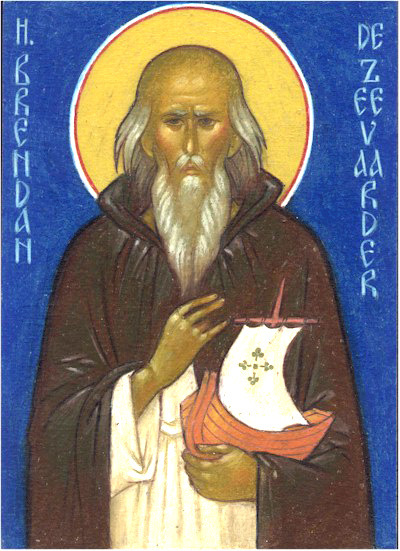
St. Brendan (Brandan, Brandon), called the “Navigator” or also the “Voyager”, is one of the greatest ascetics who lived in Ireland. Unfortunately, his earliest and most reliable hagiographies are lost, and what remains are later twelfth-century Latin and Irish manuscripts, annals, genealogies, traditions, and legends; he is also mentioned in the Lives of some other Irish saints. But, most importantly, he has been loved and venerated by the Irish as one of the nation’s most important Church figures throughout the centuries. According to various traditions, he was born in 484 or 486 and reposed in 575, 577, or 583 at nearly 100. The names of his parents were Finnlug and Cara. The future saint’s birthplace was most probably tiny Fenit Island, situated northwest of the fishing village of Fenit in County Kerry, six miles from the town of Tralee, in the very southwest of Ireland. In the 2000s, a massive statue of St. Brendan was erected on neighboring Great Samphire Island at the entrance to Fenit Harbor to commemorate him.
Fenit, St. Brendan's birthplace, with the harbor and island (taken from Wikipedia)
St. Brendan was baptized as an infant by the holy Bishop Erc of Slane; the night Brendan was born, Bishop Erc saw a great light and a multitude of angels in glowing robes descending from heaven over his parents’ home. Tobar na Molt holy well not far from Tralee and Ardfert, where St. Erc baptized St. Brendan, still exists and is visited by pilgrims seeking physical and mental healing and consolation. There is a chapel near this well with an altar and the figures of three saints (Sts. Brendan, Erc, and Ita). St. Erc may later have ordained St. Brendan as a priest.
Tobar na Molt holy well, in which St. Brendan was baptized, Kerry (photo by Bernard, Geograph.ie)
According to tradition, at the age of two, little Brendan was given by St. Erc to the care of the illustrious holy Abbess Ita († c. 570; feast: January 15) of Killeedy in Limerick, known as “the Foster-mother of the Irish Saints.” Under St. Ita Brendan studied the rudiments of Christianity for five years, and he retained the love and respect for the abbess who nurtured and taught him always. After Killeedy, St. Brendan is believed to have gone to Tuam in Galway, to the famous monastery and school founded by St. Jarlath († c. 540; feast: June 6). Besides, St. Brendan was a disciple of St. Enda of Inishmore (+ c. 530; feast: March 21), one of the earliest monastic founders in Ireland.
Our saint also went to the famous Clonard Monastery in County Meath with the great St. Finnian († 549; feast: December 12), “the Teacher of the Irish Saints”, or one of his successors. Notably, St. Brendan the Navigator (like his saintly namesake, St. Brendan of Birr in Offaly, who reposed in c. 573 and is feasted on November 29) is ranked among “the Twelve Apostles of Ireland,” all of whom were in Clonard. Lastly, tradition says that the young saint traveled to Wales, where he spent some time with St. Gildas (or St. Cadoc) at Llancarfan in Glamorgan, in the monastery famous for its learning. Irish and Welsh monasticism of the age were closely interconnected.
Having been instructed by such celebrated monastic saints, St. Brendan has tonsured a monk, ordained, and then journeyed to the west of his native Ireland to found churches, do extensive missionary work, and shepherd his fellow countrymen. All his biographers wrote that St. Brendan led an austere ascetic life and gained fame as a wonderworker. He excelled in extraordinary zeal for prayer, extreme abstinence, profound humility, and great mercy and love for everyone. In Ireland and Scotland (which he visited many times) St. Brendan established many monasteries. The most famous of them, founded in about 559, was Clonfert, on the west bank of the River Shannon in County Galway. Clonfert, set up by St. Brendan, was renowned all over Ireland. At one time, it is said that it had some 3,000 monks, and future missionaries who later traveled all over Europe to preach the Gospel. One of the most illustrious disciples of Clonfert, who in his youth may have been instructed by St. Brendan, was St. Fursey († c. 648; feast: January 16), who later founded monasteries in Eastern England and France.
Another significant establishment of St. Brendan was the monastery and diocese of Ardfert, which became a large ecclesiastical and monastic center of Kerry close to the saint’s birthplace. Then he established a community at Inis-da-druim, now Coney Island (Innisdadrom) in County Clare. After that he built a monastery at Annaghdown in Galway, by the Bay of Annaghdown near Lough Corrib.
Numerous traditions tell that St. Brendan was also active in the historic Irish province of Leinster, where a host of places are associated with him. Let us mention the parish of Disart in County Kilkenny, Killeney (which still has a church in honor of St. Brendan) and Brandon Hill in Kilkenny. About 1700 feet tall, Brandon Hill, named for St. Brendan, is the highest mountain in County Kilkenny; St. Brendan built a monastic community or church beside it.
Later establishments of St. Brendan worth mentioning are a monastery on the island of Inchiquin, also called Innisquin, in the parish of Killursa in Galway, along with a monastic community on Inishglora off the Mullet Peninsula in County Mayo. For the past 100 years, this island has been uninhabited. Inishglora is noted for its ancient relics related to our saint. Two monastic communities—one for monks and one for nuns—may have existed here simultaneously. Today you can find the ruins of the early St. Brendan’s Church, a “church for men”, and a “church for women” there and drink water from St. Brendan’s holy well, used by local monks in the first millennium! Very ancient cross shafts and other artifacts are situated near the remains of three early beehive cells, one of which belonged to St. Brendan.
Legends associated with Inishglora abound. The historian Gerald of Wales in the late twelfth century testified that as long as monks inhabited this island, human corpses were neither buried nor decayed on it—many bodies were deposited in the open so that people could see their ancestors absolutely uncorrupt for generations (this phenomenon must have ceased when the monks left). The same historian also wrote that vermin, such as mice and rats, never inhabited Inishglora as long as prayer was performed. Though thousands swarmed on other Irish islands, none was found there. Whenever someone brought a rodent to Inishglora, it would instantly run away and leap into the sea or die if it was stopped. Formerly all ships sailing past Inishglora would lower their topsails to pay homage to St. Brendan, whose wonderworking wooden statue stood inside St. Brendan’s Church. Garlic that grows on Inishglora to this day is said to have been planted by monks 1500 years ago!
The more significant part of St. Brendan’s life was spent in travels and voyages (typical for Irish monks and ascetics), which is why he was later nicknamed the “Navigator”. In the eighth and ninth centuries, the famous saga, Navigatio Sancti Brendani (The Voyage of St. Brendan), was composed by an Irish monk, and later other authors wrote more elaborate versions of it. Though famous throughout the Middle Ages, this saga transformed the authentic seafaring ascetic and abbot into a semi-mythical adventurer with supernatural abilities who accomplished unbelievable exploits. According to it, when Brendan was abbot of Clonfert, a monk Barrindus1 once visited him. The monk told him that he had traveled through a thick fog and reached the “heavenly Jerusalem”, full of precious stones, in which the sun never set; there were many mountains, birds sang sweetly, a river flowed from the east to the west, and all the plants were always in bloom. Barrindus had spent a year there...Continue reading orthodoxchristian
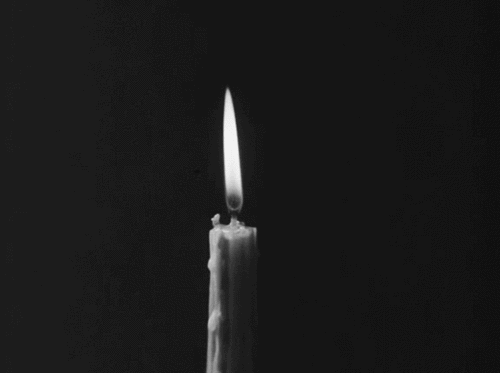
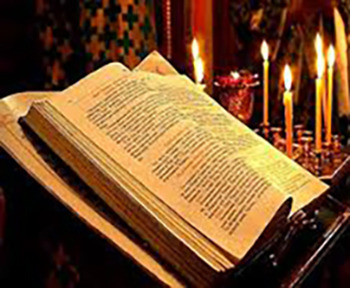
ACTS 21:8-14
8 On the next day we who were Paul's companions departed and came to Caesarea, and entered the house of Philip the evangelist, who was one of the seven, and stayed with him. 9 This man had four virgin daughters who prophesied. 10 And as we stayed many days, a certain prophet named Agabus came down from Judea. 11 When he had come to us, he took Paul's belt, bound his own hands and feet, and said, "Thus says the Holy Spirit, 'So shall the Jews at Jerusalem bind the man who owns this belt, and deliver him into the hands of the Gentiles.' " 12 When we heard these things, we and those from that place pleaded with him not to go up to Jerusalem. 13 Then Paul answered, "What do you mean by weeping and breaking my heart? For I am ready not only to be bound but also to die at Jerusalem for the name of the Lord Jesus." 14 So when he would not be persuaded, we ceased, saying, "The will of the Lord be done."
JOHN 14:27-15:7
27 Peace I leave with you, My peace I give to you; not as the world gives do I give to you. Let not your heart be troubled, neither let it be afraid. 28 You have heard Me say, 'I am going away and coming back to you.' If you loved Me, you would rejoice because I said, 'I am going to the Father,' for My Father is more significant than I. 29 And now I have told you before it comes, that when it does come to pass, you may believe. 30 I will no longer talk much with you, for the ruler of this world is coming, and he has nothing in Me. 31 But that the world may know that I love the Father, and as the Father gave Me commandment, so I do. Arise, let us go from here.
1 I am the true vine, and My Father is the vinedresser. 2 Every branch in Me that does not bear fruit He takes away; and every branch that bears fruit He prunes, that it may bear more fruit. 3 You are already clean because of the word I have spoken to you. 4 Abide in Me, and I in you. As the branch cannot bear fruit of itself unless it abides in the vine, neither can you unless you abide in Me. 5 I am the vine, you are the branches. He who abides in Me bears much fruit, and I in him; without Me, you can do nothing. 6 If anyone does not abide in Me, he is cast out as a branch and is withered; they gather them, throw them into the fire, and are burned. 7 If you abide in Me, and My words abide in you, you will ask what you desire, and it shall be done for you.
#orthodoxy#orthodoxchristianity#easternorthodoxchurch#originofchristianity#spirituality#holyscriptures#gospel#bible#wisdom
2 notes
·
View notes
Text

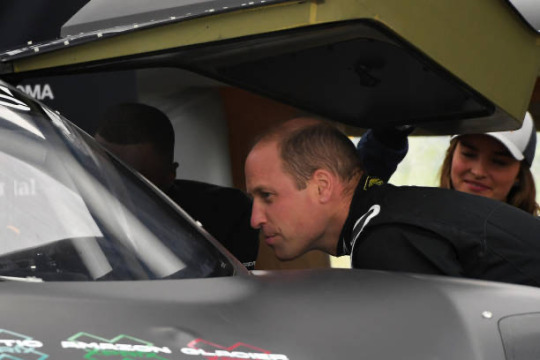


Knockhill Racing Circuit - 22 May 2021
The Duke of Cambridge test drives the Extreme E Odyssey 21 electric vehicle during his visit to the Knockhill Racing Circuit in Fife, Scotland. (📷Getty Images)
45 notes
·
View notes
Text
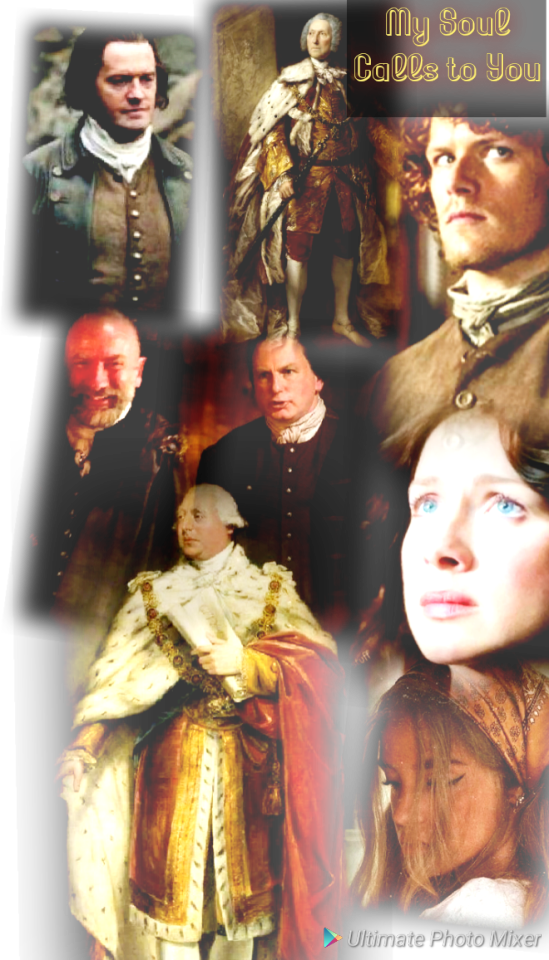
My Soul Calls to You Chapter 21
AO3
Brian sat next to their host, the Duke of Argyle, with the Mackenzie brothers, Column and Dougal across from them. The Duke is questioning them. “I understand that you and your war chief are trying to start a civil war. Do I have that correct?” Brian says nothing. He is their as a guest, a witness and, a supporter of the Duke of Argyle. Column looks to the Duke with wonderment. When he doesn’t answer, he is asked again, “Why are you trying to start a Scottish civil war?”
“I will be the next Scottish king of Scotland, replacing the English king, a step towards removing the English from our God given land!” he raises his voice just short of a yell.
“You won’t take the Kingship and King James will not either. It is time then that the clans take back their homeland.” Dougal adds.
“A fool’s errand and one we will not be discussing. King George is our king and I am loyal to him.” The Duke of Argyle replies.
“What are your feelings about this manner, Lord Lovett?” Column hopes his brother -in-law will back him up.
“I too am loyal to the king. So loyal that I would report to London and the House of Lords if I didn’t find my place to be here with my family.”
At that precise moment, Lord Grey and a group of Recoats enter to arrest Column and Dougal. “Traitors! You are all traitors to Scotland!” Column yells out as he was dragged out. Lord Grey had to hit him over the head to subdue him enough to remove him.
When it grows quiet again, The Duke of Argyle turns back to Brian, “Have you someone to see to Hamish and his mother until he comes of age?”
“Yes, Your Grace, I have a man and his wife in mind. They will go to Leoch, with your permission, to teach Hamish and oversee the land. His wife is a healer.”
The Duke nods his head. He is happy to see that Lord Lovett has a plan that will help all involved.
Back at Lallybroch, Amelia is in her croft packing. Claire enters with a package of herbs and other medical items. “I am going to miss you, my sister. I’ve never had so many women friends and now I have two sisters and one is leaving me.”
“I won’t be to far. Only at Leoch, working. You can come visit.” Amelia will miss her too. There’s a sisterhood at Lallybroch. She doubts she will find the same with Leticia.
“We shall. Once this wee one is born and the children are older.” The hug tight before Claire leaves to help Jenny with the goodbye dinner they are preparing for Amelia and Willie.
Jamie walks to the dooryard to see his wife walking towards the house. She is crying. He runs towards her, “Sassanach, what is wrong?” she clings to him, crying against his chest, “My love, tell me?”
“Amelia is leaving to go to Leoch. I am losing a friend who is like a sister. I never really had friends growing up, with all the moving we did. Even during the war, the other nurses I worked beside were only colleagues. Everything was to uncertain to develop true friendships. But Jenny and Amelia, they are my friends and sisters. They have really been here for me, they and you.” She explains through her tears.
Jamie holds her, soothing as he thinks. He knows her past in the future had been hard. He vows that when the children are older, by a year, he would take her to Leoch to see her and Amelia had time together. To hold his world in his arms, to comfort her as she wept, that feeds his soul.
In London, Column and Dougal are hung for treason. King George watches. He will need to talk to the Duke of Argyle and Lord Lovett to see about a way to stop a potential civil war. It may not be only clan leaders that wish to revolt against the Crown.
#my writing#outlander fanfic#my soul calls to you#chapter 21#jamie and claire#cannon divergence#outlander fandom
4 notes
·
View notes
Text
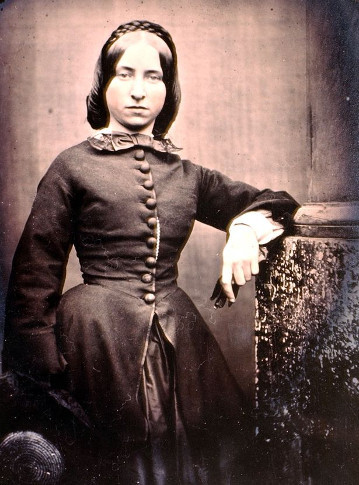

On 12th of April 1928 Madeleine Smith who stood trial in one of Scotland's most sensational trials died peacefully in New York
Sex,blackmail, poison and death. With this heady mix it is hardly surprising that one of the most enduring murder cases from the past 150 years is the story of Madeleine Smith.
The 21-year-old beauty was the daughter of a well known Glasgow architect and socialised in high circles until she was charged with the murder of a previous lover.
Her one-time lover had been Pierre Emile L’Angelier of Jersey. The Crown alleged that she had administered arsenic to him between 19th February and 23rd March that year, at or near her father’s house. L’Angelier had collapsed suddenly at his lodgings in Glasgow on 23rd March. He was found in a doubled-up position at the door in the early hours of the morning and despite constant medical attention by a doctor he died the following day. After his death, his family insisted a post-mortem was conducted and the results were handed over to the police. A forensic examination detected over 30 grains of arsenic in his remains.
Previously, during their passionate affair, L’Angelier and Madelaine had corresponded through secret letters. L’Angelier often referred to his lover with the words "Wifie mine". On one occasion Madelaine had written, "Am I not your wife? Yes, I am", and there is reason to believe that L’Angelier assumed that they were married according to Scots law.
After L’Angelier’s death investigators uncovered the secret correspondence between the pair which revealed their passionate liaison and helped piece together the events surrounding L’Angelier’s suspicious death. It was discovered that, despite her affair with L’Angelier, Madelaine had been attracted to a Mr Minnoch, a high class member of society. Soon after, she became engaged to Mr Minnoch and wanted L’Angelier to return the letters. L’Angelier refused and threatened to bring them to the attention of her father and Minnoch. Madelaine buckled under the threats, and was forced to maintain L’Angelier’s company. His nightly visits resumed, but on two occasions he was seized with an inexplicable illness after being given a cup of cocoa from her hands. On the evening of his death witnesses testified that he had been seen heading in the direction of Madelaine’s house.
After her arrest Madeline’s family were said to be distressed and ashamed, however Miss Smith did not seem to suffer from the same discomfort. At her trial she entered the dock with "the air of a belle entering a ballroom or a box at the opera. Her steps were buoyant and she carried a silver-topped bottle of smelling salts. She was stylishly dressed and wore a pair of lavender gloves".Throughout the trial she never appeared perturbed, and seemed to exert a peculiar fascination over the men in the court audience. She was later to tell her prison matron in a letter that she had received hundreds of letters "all from gentlemen, offering consolation, their hearts and money".
Madelaine claimed that she had not seen L’Angelier for three weeks prior to his death. In her defence she explained that a poison she had recently purchased was for killing vermin and also for cosmetic purposes, diluted with water, to wash her face, arms and neck. The prosecution case rested on the overwhelming motive that the prisoner had for disposing of her erstwhile lover. The defence proceeded to allege that there was no evidence that the couple ever met on the days in question. It was even suggested that the heartbroken L’Angelier may have taken his own life in despair.
The jury took only half an hour over their deliberations. While they were absent, it was said that the least excited person in the court was the prisoner. When the foreman delivered a verdict of "not guilty of the first charge by a majority, of the second charge not proven, and by a majority find the third charge also not proven", the result was greeted with great applause. Madelaine Smith left the trial a free woman. A short time after the trial, Miss Smith married a gentleman of good social standing in London. She emigrated to America some years later, where she married yet again. The story was famous in Victorian times for the reason that the public could not believe that a woman could be so devious. Madelaine became something of a femme fatale and was sensationalised as a devil woman who captured unsuspecting men in her web of deceit.
10 notes
·
View notes